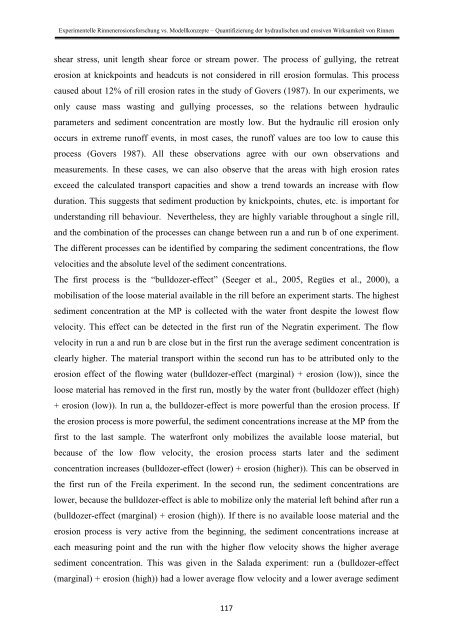Stefan Wirtz Vom Fachbereich VI (Geographie/Geowissenschaften ...
Stefan Wirtz Vom Fachbereich VI (Geographie/Geowissenschaften ...
Stefan Wirtz Vom Fachbereich VI (Geographie/Geowissenschaften ...
You also want an ePaper? Increase the reach of your titles
YUMPU automatically turns print PDFs into web optimized ePapers that Google loves.
Experimentelle Rinnenerosionsforschung vs. Modellkonzepte – Quantifizierung der hydraulischen und erosiven Wirksamkeit von Rinnen<br />
shear stress, unit length shear force or stream power. The process of gullying, the retreat<br />
erosion at knickpoints and headcuts is not considered in rill erosion formulas. This process<br />
caused about 12% of rill erosion rates in the study of Govers (1987). In our experiments, we<br />
only cause mass wasting and gullying processes, so the relations between hydraulic<br />
parameters and sediment concentration are mostly low. But the hydraulic rill erosion only<br />
occurs in extreme runoff events, in most cases, the runoff values are too low to cause this<br />
process (Govers 1987). All these observations agree with our own observations and<br />
measurements. In these cases, we can also observe that the areas with high erosion rates<br />
exceed the calculated transport capacities and show a trend towards an increase with flow<br />
duration. This suggests that sediment production by knickpoints, chutes, etc. is important for<br />
understanding rill behaviour. Nevertheless, they are highly variable throughout a single rill,<br />
and the combination of the processes can change between run a and run b of one experiment.<br />
The different processes can be identified by comparing the sediment concentrations, the flow<br />
velocities and the absolute level of the sediment concentrations.<br />
The first process is the “bulldozer-effect” (Seeger et al., 2005, Regües et al., 2000), a<br />
mobilisation of the loose material available in the rill before an experiment starts. The highest<br />
sediment concentration at the MP is collected with the water front despite the lowest flow<br />
velocity. This effect can be detected in the first run of the Negratin experiment. The flow<br />
velocity in run a and run b are close but in the first run the average sediment concentration is<br />
clearly higher. The material transport within the second run has to be attributed only to the<br />
erosion effect of the flowing water (bulldozer-effect (marginal) + erosion (low)), since the<br />
loose material has removed in the first run, mostly by the water front (bulldozer effect (high)<br />
+ erosion (low)). In run a, the bulldozer-effect is more powerful than the erosion process. If<br />
the erosion process is more powerful, the sediment concentrations increase at the MP from the<br />
first to the last sample. The waterfront only mobilizes the available loose material, but<br />
because of the low flow velocity, the erosion process starts later and the sediment<br />
concentration increases (bulldozer-effect (lower) + erosion (higher)). This can be observed in<br />
the first run of the Freila experiment. In the second run, the sediment concentrations are<br />
lower, because the bulldozer-effect is able to mobilize only the material left behind after run a<br />
(bulldozer-effect (marginal) + erosion (high)). If there is no available loose material and the<br />
erosion process is very active from the beginning, the sediment concentrations increase at<br />
each measuring point and the run with the higher flow velocity shows the higher average<br />
sediment concentration. This was given in the Salada experiment: run a (bulldozer-effect<br />
(marginal) + erosion (high)) had a lower average flow velocity and a lower average sediment<br />
117
















